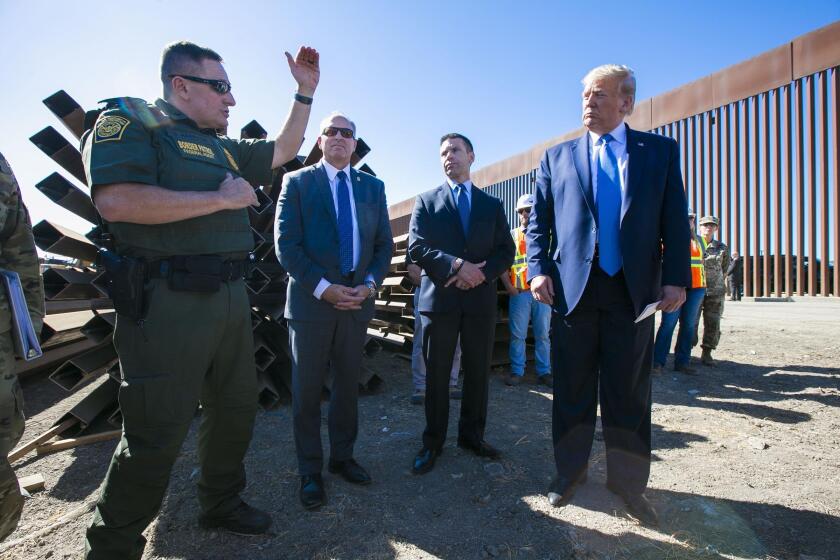California defends spending strategy for bullet train in court
California bullet train officials argued in a Sacramento courtroom Friday that they can legally tap federal money to start construction without relying on state funds now at issue in a lawsuit.
Property owners and government officials in Kings County — where some of the first sections of track are to be placed — filed the suit, claiming that because rail officials don’t know how they will pay for the entire $31-billion operating segment, they are violating restrictions established by voters in 2008.
In August, Sacramento Superior Court Judge Michael Kenny agreed, ruling that the state’s financial plan does not comply with Proposition 1A. At Friday’s hearing, he gave the Kings County plaintiffs and lawyers defending the California High-Speed Rail Authority a chance to explain how they might overcome that obstacle. He is expected to rule within 90 days.
Attorneys for the authority contended that they can use federal grants worth $3.24 billion to start the work and don’t need to immediately draw on matching funds that would come from a $9-billion sale of state bonds. That would keep the project alive and buy time to put together a complete financing plan.
“Right now, the authority is walking a fine line of moving this project along and complying with the bond act,” said Michele Inan, a deputy attorney general representing the agency.
Kenny, however, denied a request by the plaintiffs for a temporary restraining order to block the use of federal money for construction of the system’s first segment. He called the request “premature.”
Critics say the state’s novel defense strategy on display Friday exposes the rail authority to additional financial risk.
The federal money carries a requirement that the state provide matching funds. Otherwise, federal railroad officials would have the right to demand repayment.
“It is creative accounting,” said Paul Dyson, president of the Rail Passenger Assn. of California, which supports high-speed rail but also has criticized the current plan. “It is going to lead from one evil consequence to another,” he added, including the possibility that taxpayers end up with only a partially completed section of track in the Central Valley.
The authority declined to comment on its legal strategy. But Jeff Morales, the rail agency’s chief executive, said, “It’s been made very clear that this isn’t about compliance with Prop. 1A, it’s about a handful of people who want to kill this vitally important project for the future of California.”
State and Obama administration officials also said that legal, financial and technical obstacles are normal in big government infrastructure projects and the benefits of a bullet train system are worth taking some risks.
At an industry conference this week, Morales said, “These things are never easy. They are done by people who are willing to stick to it. The biggest issue in this project is stick-to-it-ness.”
Authority officials are anxious to start construction after a series of delays that have pushed back the original schedule by a year and a half. Large-scale building activity now is expected to begin in the second quarter of next year, according to Ron Tutor, who heads the project’s lead construction firm.
Critics warn the state is flirting with a potential financial disaster.
“It is not normal for the state to take on these kinds of risks,” said former Bay Area state Sen. Quentin Kopp, a onetime high-speed rail advocate who is now a leading critic of the construction plan. “The legislative intent was to preclude taxpayer liability or exposure.”
Initially, the state plans to build 130 miles of track from Madera to Bakersfield in the Central Valley for $6 billion, a first leg of a 220-mph line that would connect Los Angeles to San Francisco by 2028. The federal government has committed $3.24 billion in grants and the state had pledged to match that with $2.8 billion, part of a $9-billion bond measure.
But the rail bond measure contains restrictions, including a mandate to identify all of the funding for a first operating segment before construction begins. Officials say completing the first segment would cost $31 billion, several times the total state and federal funding now earmarked for the project.
The plaintiffs, Kings County and two residents, are asking the judge to rescind construction contracts that have been issued and prevent state officials from moving ahead until they comply with state law.
So the rail authority shifted legal tactics, arguing that it could begin building using only federal funds.
The legal issues could drag on for years with appeals. The size of the state’s financial risk would depend on how much federal money would be spent while the legal issues are being resolved.
Kopp, who has served as a judge, said both sides have presented “plausible” legal arguments. If Kenny focuses on the broader intent of voters when they approved safeguards to prevent a partially finished system, then the state is likely to lose the case, he said.
Stuart Flashman, an attorney representing the plaintiffs, claims that the state’s new strategy to begin construction still violates state law. Using federal money creates a financial obligation to contribute state money, he said.
Flashman argued Friday that the theme of the case is the commonly known admonition: “When you find yourself in a hole, the first thing to do is stop digging.”
“We think the authority is in a hole,” he said. “We think the appropriate thing for the authority to do is to stop digging but they don’t seem inclined to do that.”
The Obama administration modified its grant agreements last December to allow federal funds to be spent first with the proviso that the government could demand repayment if the project faltered. Nonetheless, the administration is encouraging the state to begin construction.
At Friday’s court hearing, John Tos, a Central Valley almond grower who brought the case, said he hoped the project would be quashed.
“It needs to go back to the voters,” he said. “You need … to see whether or not they really want this.”
Times staff writer Dan Weikel contributed to this report.
More to Read
Sign up for Essential California
The most important California stories and recommendations in your inbox every morning.
You may occasionally receive promotional content from the Los Angeles Times.












